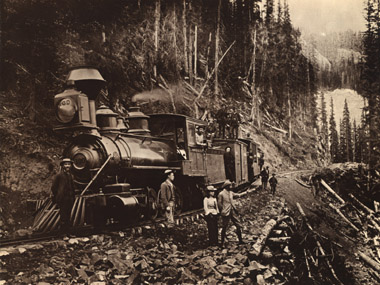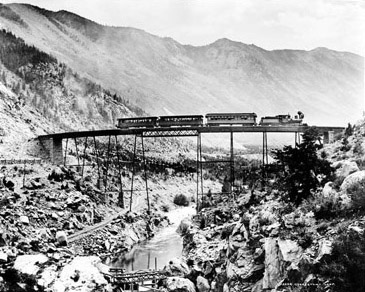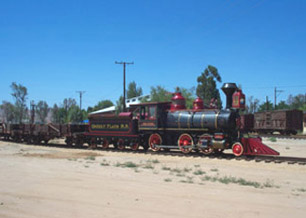Short Line Railways Provide Local Transportation
 Short line railways were built
connecting outlying mining, agricultural and lumber areas with the rivers and main railroad lines. Replacing wagons and stage
lines, they provided faster and more reasonable transportation for passengers, mail and goods, aiding the economic development
of the areas they served.
Short line railways were built
connecting outlying mining, agricultural and lumber areas with the rivers and main railroad lines. Replacing wagons and stage
lines, they provided faster and more reasonable transportation for passengers, mail and goods, aiding the economic development
of the areas they served.
A short line is an independent railroad company that operates over a relatively short distance. Short lines railroads typically are built to either:
- link two industries requiring rail freight together;
- interchange revenue traffic with other, usually larger, railroads or boats;
- operate a tourist passenger train service.
Often, short lines exist for all three of these reasons.
The earliest railroads were built as short lines, locally chartered, financed and operated. As the railroad industry matured and traffic increased, local lines were merged or acquired to create longer mainline railroads. The first railroads in California were built as short line railroads, many were later incorporated into the Central Pacific, Southern Pacific and other mainline railroads.
The Sacramento Valley Railroad began service in 1856 from Sacramento to Folsom, hauling ore, food, goods and passengers along the 22 mile line between Placer and the river docks in Sacramento. Similar railroads were built to connect other mining communities in the Sierra Foothills. The 22 mile long Los Angeles & San Pedro Railroad was completed in 1869 linking Los Angeles and the harbor, the first railroad in Southern California. This railroad later became part of the Southern Pacific Railroad. Read more about early California railroads.
In Nevada, the Virginia & Truckee connected the Virginia City Mining Region with the Carson River in 1869, where water power for the extraction of ore was readily available. Tracks were extended to interchange with the Central Pacific in Reno in August 1872, a total of 52.2 miles, enabling more economical transportation of timber and machinery making the mining operations achievable. Today the Virginia & Truckee has been reborn between Virginia City and Gold Hill to provide tourist passenger service. Read more about the Virginia & Truckee.
Narrow Gauge Railroads
 When the first transcontinental railroad was built, President Abraham Lincoln established
the track gauge, or distance between the rails, to 4 ft. 8 1/2 inches. While not a universal standard at the time. George
Stephenson, adapted the gauge of the early colliery lines when he was developing the early steam railroads and locomotives
in England. This gauge became the most commonly used standard in England and Scotland by 1846. Parts of the United States rail
system, mainly in the northeast, adopted the same gauge because some early locomotives and cars were purchased from British
manufactures. In the Southern states five foot gauge was more popular prior to the Civil War. The
majority of railroads in the East adapted the 4 ft. 8 1/2 inches standard within a decade following the Civil War, allowing
freight cars to be interchanged with other railroads.
When the first transcontinental railroad was built, President Abraham Lincoln established
the track gauge, or distance between the rails, to 4 ft. 8 1/2 inches. While not a universal standard at the time. George
Stephenson, adapted the gauge of the early colliery lines when he was developing the early steam railroads and locomotives
in England. This gauge became the most commonly used standard in England and Scotland by 1846. Parts of the United States rail
system, mainly in the northeast, adopted the same gauge because some early locomotives and cars were purchased from British
manufactures. In the Southern states five foot gauge was more popular prior to the Civil War. The
majority of railroads in the East adapted the 4 ft. 8 1/2 inches standard within a decade following the Civil War, allowing
freight cars to be interchanged with other railroads.
In the 1870's narrow gauge promoters argued that railroads using track with rails 3 feet apart could be built faster and at a lower cost than standard gauge lines. Narrow gauge railways could be built with smaller radius curves and smaller structural components, they could be substantially cheaper to build, equip, and operate than standard gauge or broad gauge railways, particularly in mountainous terrain. Reduced costs attracted investors, and in some cases made it possible to build a railroad which may not have been financially feasible otherwise.
In Colorado, the Denver & Rio Grande Railway was built as a three foot gauge railway, the smaller gauge allowing the builders of the D&RG to realize a savings in the costs of construction, locomotives, cars, rails, ties, grading, etc. The remote mining regions could be reached more quickly and economically than if standard gauge were used. Construction of the D&RG began in January 1871. The railroad became a model for numerous other narrow gauge railways during the 1870's and 1880's and started a fever of narrow gauge railroad building throughout the western United States. Read more about the Denver & Rio Grande.
The South Pacific Coast Railroad was a three foot narrow gauge short line railroad, connecting the San Francisco Bay area with San Jose and Santa Cruz. The busy railroad served varied commuter, lumber, agricultural and mining interests. The SPC began construction of its line between Dumbarton Point and Newark, in 1876. Construction of the line reached San Jose by the end of 1877. Read more about the South Pacific Coast.
The Nevada Central three foot narrow gauge line was completed in 1880 to connect the mining region surrounding Austin with the Central Pacific at Battle Mountain, 92 miles away.
The Carson & Colorado was built during the early 1880's. The 293 mile long narrow gauge short line railroad connected the Virginia & Truckee Railway at Mound House with the mining towns south of the Carson Valley. Stations included Dayton, Hawthorne and Candelaria in Nevada, Benton Station, Laws, Kearsarge, Owenyo and Hawley (later Keeler) in California. Read more about the Carson & Colorado.
A number of other narrow gauge short lines were built, most were short lines serving mining, agricultural and lumber communities; typically connecting with the transcontinental lines. By reducing transportation time and costs they aided in the areas' economic development. Some were hastily built and lasted only a few years, closing when the mines closed and people moved elsewhere.
Narrow Gauge vs. Standard GaugeIncompatibility with connecting standard gauge railroads required unloading freight from standard gauge cars and reload the freight into narrow gauge cars, and visa versa for shipments originating on the narrow gauge railroads, raising operating costs and slowing shipping. The smaller capacity of narrow gauge cars also increased operating costs. As early as 1887, many lines began conversion to standard gauge so as to remain competitive.
Competition from other railroads forced both the D&RG and RGW to convert their mainlines to standard gauge. Construction to support the standard gauge in Utah began in the spring of 1889, the mainline from Ogden to Provo (82 miles) was converted in 1889. The D&RG mainline conversion was completed Nov 14, 1890, allowing standard gauge traffic to pass along the D&RG and RGW transcontinental line. Several of the lower traffic branch lines, however, remained narrow gauge.
The narrow gauge boom had ended. By 1905 less than half the miles of narrow gauge track built in the U.S. remained. In addition to the D&RG branch lines, several of the lower traffic short lines remained narrow gauge, generally those serving communities where the traffic potential would not justify the costs of converting to a a standard gauge line.
|
OERM's short line collection includes nineteenth century wood freight and passenger cars, steel freight and passenger cars, steam locomotives, diesel locomotives, documents and photographs. Several short line railways are represented including the Ventura County, Virginia & Truckee, Denver & Rio Grande, Nevada Central, Carson & Colorado, and South Pacific Coast. The oldest standard gauge cars are exhibited in the Hugh Smith Car House No. 4, newer cars and locomotives are exhibited outside the Hugh Smith Car House No. 4 or displayed in the Pie Yard. Narrow gauge cars and locomotives are exhibited in the Grizzly Flats Enginehouse No. 6. |
Sharing A Heritage Railroad History Train Technology Railroad Operation Railroad Time Museums & Heritage Railroads Railroads Today
Entire web site copyright 2002-2013, DigitalNetExpress.com, Burbank, California. |

